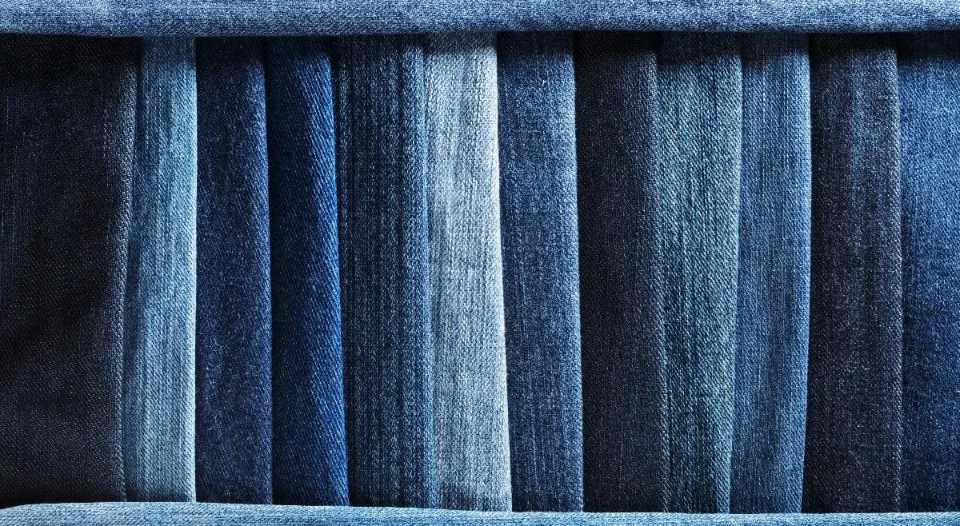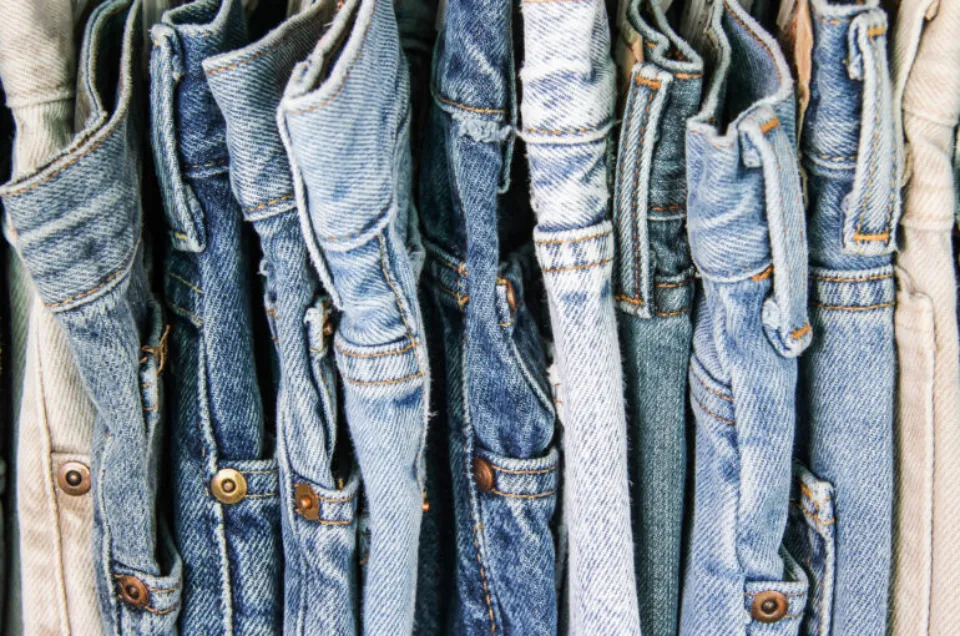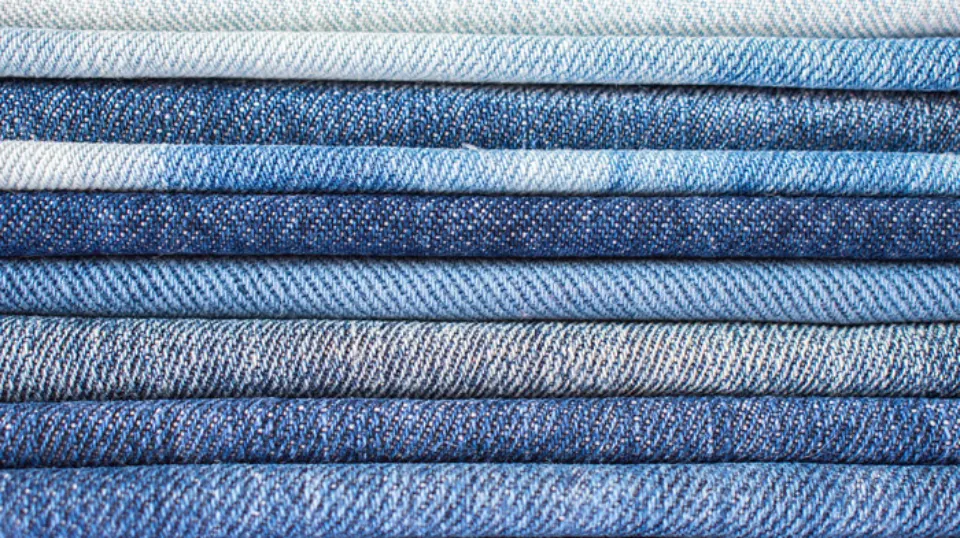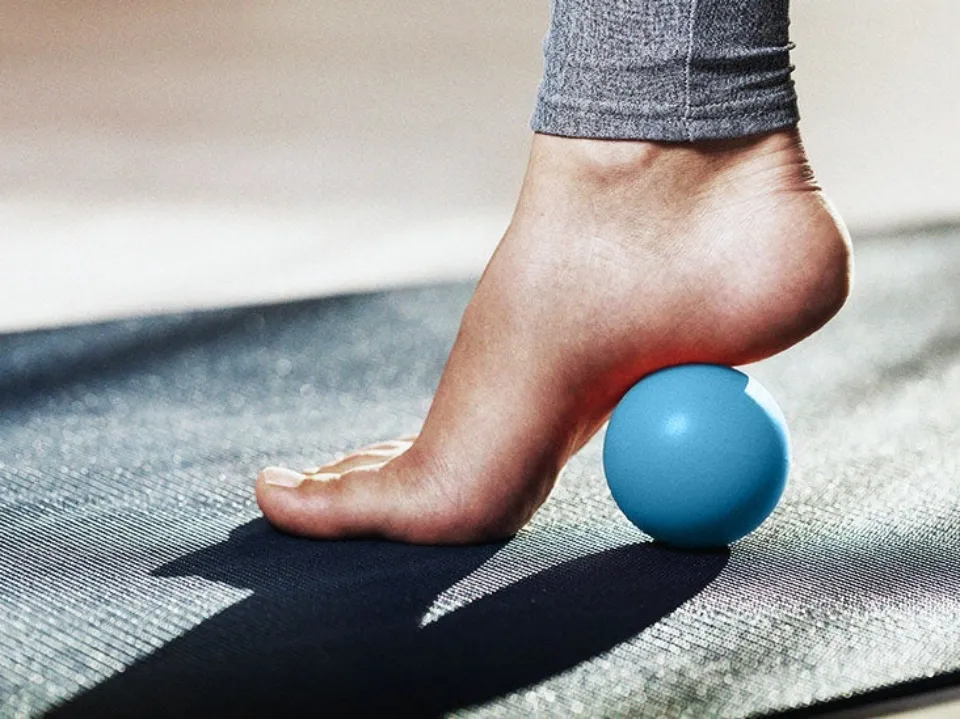One of the most recognizable textiles in the world is denim. The moment you say the words “denim jeans,” everyone around you knows what you’re talking about. But what is denim exactly?
Denim is a type of woven twill fabric, usually made from cotton.
Why has its enduring popularity persisted over the years? As we cover everything you need to know about denim fabric, we’ll delve into all these queries and more.
What is Denim?
Denim is a strong cotton fabric made using a twill weave, which creates a subtle diagonal ribbing pattern.
The cotton twill fabric is warp-facing, which means that the weft threads are tucked under two or more warp threads and that the warp yarns are more noticeable on the right side.
The diagonal ribbing distinguishes denim fabric from canvas or cotton duck, both of which are robust woven cotton fabrics.
The History of Denim Fabric
Denim was first produced in the city of Nîmes in France, and was originally called the serge de Nîmes. The word denim is an English colloquialism of the French term: “de nim.”
When Levi Strauss opened a store in San Francisco during the Gold Rush, selling dry goods along with buttons, thread, and tent canvas, denim gained popularity in the United States. He started making robust pants for miners with roomy pockets for gold storage.
One of Strauss’s clients, Jacob Davis, strengthened the seams and pocket corners by adding copper rivets.
The pants were patented by David and Strauss, who also helped them transition from a garment worn only by working men to a commonplace fashion item through mass production and marketing.
What Different Types of Denim Fabric Are There?

Numerous variations of denim have been created over time.
Here’s some information on a few of the most popular options:
1. Raw Denim
This type of denim has not been washed or treated. It is typically left on for six months to a year without being washed to ensure that it molds to the wearer’s body.
For the purpose of killing bacteria and microbes, fans of raw denim frequently resort to freezing their jeans.
2. Sanforized Denim
Sanforization, the washing procedure that produced the modern denim fabric, has been applied to the majority of denim types.
Sanforized jeans are softer than raw denim jeans, but they also tend to be less sturdy and customizable.
3. Stretch Denim
With this kind of denim, spandex or a comparable fabric has been combined with cotton.
Since the resulting fabric is more stretchy than regular denim, it is frequently used in tight-fitting garments like skinny jeans.
4. Crushed Denim
The weave of this variety of denim is comparable to velvet. It looks permanently wrinkled, which makes it desirable for skirts and jackets.
5. Selvedge Denim
Often used to make jackets, selvedge denim has a fringe at the end.
6. Acid Wash Denim
This variety of denim has a well-known spotted appearance. When raw denim is washed in a potent acid, the dye is eaten away, creating the product.
7. Poly Denim
The term “poly denim” is widely used to refer to denim products that are made with a mix of cotton, polyester, and any number of other artificial fibers.
When producing denim, cotton is occasionally combined with polyester, lyocell, and nylon. Some purists would say that poly denim is not “real” denim.
How is Denim Fabric Made?
There are a few stages that culminate in the production of finished denim fabric products:
Cotton Cultivation
The cultivation of the cotton plant is the first step in the creation of denim.
In order to protect its tiny black seeds, this plant grows a thick ball of fibers around them. These fibers can be gathered and separated from the seeds to make fabric.
Processing into Yarn
Long, thin strings are created by combing cleaned cotton fibers. Then, a commercial machine spins them into yarn.
Numerous washes, dyes, or other treatments that alter the characteristics of the finished denim product may be used during this process.
Final Production
It is woven into the recognizable warp-faced denim style after cotton yarn has been created and dyed. Typically, this fabric is made into bolts that can be bought by the yard, shaped into finished consumer goods, and then sold.
How is Denim Fabric Used?
This cotton product is used in several sectors:
Apparel

The majority of denim is utilized in clothing. Examples of denim apparel items include:
- Jeans
- Skirts
- Shirts
- Blouses
- Jackets
- Vests
Accessories
Denim is also commonly used in accessories like:
- Shoes
- Belts
- Purses
- Hats
Homewares
As denim has become a fashion icon as well as a practical fabric, this textile has found its way into the homewares market in the following categories:
- Drapes/curtains
- Upholstery
- Blankets/duvets
- Pillows
How Much Does Denim Fabric Cost?
Cotton is one of the most affordable natural fabrics; in fact, its cost is on par with that of low-cost synthetic fibers like rayon and polyester.
Cotton yarn isn’t that much more expensive to turn into denim, which places the price of denim fabric in the middle of the fabric price spectrum.
Certain types of denim, however, can be quite expensive. For example, raw, organic denim can cost several dollars per yard, and generally speaking, products made of cotton that were produced sustainably and ethically cost a little bit more.
However, consumers are increasingly looking for safe, organic textile products, which leads to greater long-term profits. Supporting good companies is worth the additional cost.
Also Read: Do Zara Jeans Shrink?
Conclusion: What is Denim
Even though denim is well known worldwide, it is helpful to learn more about what is denim fabric.
Denim is known for its durability, so it has been used in various ways aside from clothing. Additionally, you have picked up a few pointers on proper denim sewing technique. This is crucial because working with denim can be a little challenging because of how thick it is.
Finally, remember how to take care of your denim so that it will last for a long time.
Read More:
FAQs
What is Denim Made Of?
Cotton is used to make real denim. You need 100% cotton in your denim to provide that perfect texture.
Who Invented Denim?
Denim, as we know it today, originated in 1860, when By Levi Strauss & Co., which was making work pants out of a stiff canvas fabric, added serge de Customers who wanted a softer, less chafing fabric asked for changes to be made to the company’s product line.
What is Denim Used For?
It is utilized in the creation of, among other things, clothing, accessories, furniture, and automobiles.




